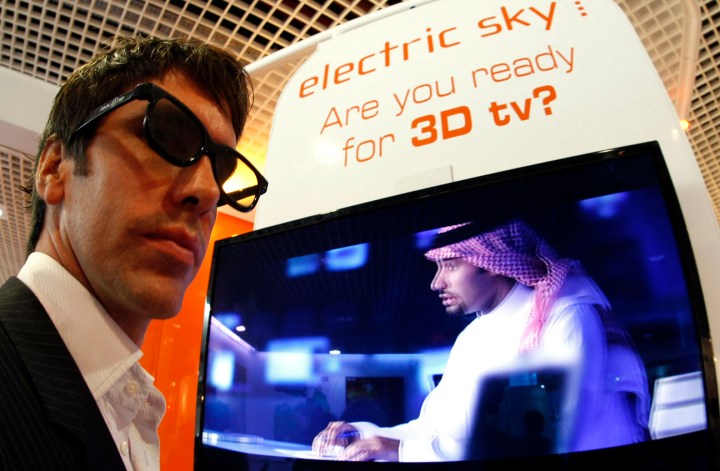Business Maverick, Sci-Tech
Analysis: Why you won’t be buying a 3D TV (until you are forced to)

Every consumer electronics company in creation is launching 3D television sets this year. They’re counting on you tossing your two-year-old flatscreen in the bin and spending big on one of these babies. They’re wrong about your wish to play along, but they’ll get you in the end.
The Consumer Electronics Show in Las Vegas has become the biggest of its kind in the world, and this week every major player is using it to announce new product lineups for 2010. By far the biggest new category is 3D TVs. Everybody’s got one, and they’re counting on early adopters buying them this year, the richer middle classes to follow in 2011, and everybody to have one in the lounge before 2015.
They are almost entirely wrong.
For decades manufacturers were assured of a steady stream of business; first it was the fancy new black and white TVs, then bigger screen sizes, then colour TV, then brighter displays, then bigger displays, then non-curved displays, then black matrix displays, then various flavours of flatscreen, then HDTV. Each generation was more lucrative than the previous one because per-unit manufacturing costs dropped while the price consumers were willing to pay increased. It was a fantastic market to be in, as long as you didn’t invest in capital equipment too late and got stuck with worthless machinery.
This taught the TV-manufacturing industry two lessons: the market is always hungry for the next big thing, and being on the cutting edge is safer than being behind the curve. So, by those rules, 3D TVs will sell like hotcakes and the time to start selling them is ASAP.
Take a close look, however, and the numbers tell a different story. LCDs haven’t replaced plasma screens at nearly the rate that was expected, and non-HD flatscreens aren’t being replaced fast either, despite the increasing availability of HD programming. In fact, the last big upgrade cycle was from TVs with big-ass tubes to flatscreens; the former were thrown out in such quantities that many countries still have piles of the things waiting to be recycled or safely disposed of.
Moving from a black and white TV to a colour TV was a giant leap upward in the quality of entertainment. Moving from a tube TV to a flatscreen was, for many, a matter of peer pressure. (Go on, admit it. You were embarrassed to have friends around and watch them snigger at your old tubed dinosaur, which is why you gave it up for something much more expensive with much worse picture quality.) 3D TV offers neither of these benefits.
For the foreseeable future, any decent 3D TV will require you to wear glasses. Big, heavy, dorky glasses with cables running from them. That will give you a picture with depth, if you happen to be watching a new 3D Blu-ray disc or one of what will be a very small number of 3D channels, but there will be you’ll be sacrificing picture clarity and brightness. For this you will be paying many tens of thousands of rands.
But the young woman you lure back to your place (and this is the single most important motivator for young men to buy consumer electronics) won’t be impressed, because she won’t be able to tell from looking at it that you have the newest Auto 3D DisplayTron With Double Depth from Sony, rather than last-seasons standard HD flatscreen. Not without turning it on, certainly.
So you can spend a lot of money to make your viewing experience more uncomfortable and impress nobody but your geek friends, or spend a little money and buy an awesome last-generation set that you can watch without plugging your face into it. Factor in competing standards, uncertainty about how future-proof early models will be, and you’re left with a vanishingly small initial market. Which means higher unit prices, which will further decrease uptake.
Still, they’ll get you in the end, whether you like it or now. That plasma on your wall isn’t going to last forever, and by the time it burns out you probably won’t have a choice. The manufacturers who have and will continue to spend so big on tooling up for 3D aren’t going to maintain their old-style production lines indefinitely. By the time you buy again, the only thing on the shelves may be various flavours of 3D. Just hope it will have improved by then.
By Phillip de Wet
Follow Phillip on Twitter: @phillipdewet
Read more: BBC News, Sydney Morning Herald, Popular Mechanics
More tech analysis: The iSlate cometh – to a living room near you


















 Become an Insider
Become an Insider